thank you for that information...im so excited im going to count the bricks now...lol...ive used this almost 20 yrs and didnt know any of this

Its a double door with 8 inch pipe and 5 bricks. What are you meaning when you say the "shields"?
Your stove is a Grandma I IF it has flat top doors. It is a Grandma III IF it has arched top doors.
It's not as simple as that, so pictures all the way around are sometimes needed.
1976 was the first year for double door stoves. They had no shields which are added steel sheets to the rear and bottom. Stoves with no shields having old style flat top doors would be a Roman Numeral I.
Drawing revisions were sent to the licensed fabricators as improvements were made, and 1977 drawings included optional bolt on shields (added sheets to drawings specified 20 GA Cold Rolled Steel) for installation on other than non-combustible fireplace hearths. These were designated Model II on the prints in 1977, the Roman II was used internally company wide, but the designation was not used in advertising, brochures or marked on stoves.
1979 started optional "Cathedral" arched top doors that became the only style available after 1980 to the end of production. Flat and Cathedral co existed this year only becoming the Model III.
1980 started the redesigned one piece, bent corner box that was still designated III. All the new style boxes had welded shields and were UL listed. They also had Smoke Shelf Baffles to reduce smoke particulate. Only double door stoves of the Fireplace Series were designated III. Later glass double doors were IV and had rear shield bolted on with optional blower under shield at rear. All single door stoves of the Bear Series went from II to VI. Stoves like the Coal Bear, Honey Bear, Teddy and Goldilocks (no Roman Numerals) had double shields welded in place for close clearance.
What makes it complicated is most fabricators continued to offer stoves fabricated in the first design with angle iron corners long after 1980 when only arched top doors were available. They were $100 cheaper for those installed on non-combustible hearths or cement floor basements and were not UL approved. That was not necessary until years later as laws changed. Below Grandma III front and back with shields compared to the old style box with Cathedral doors difficult to date with no UL tag.
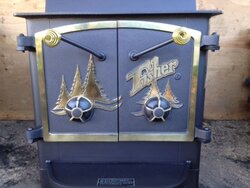
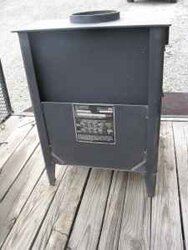
1980 to '88 designated III.
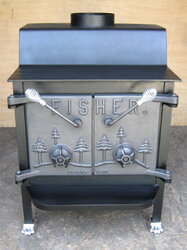
Old style box with pre 1980 flat top doors. NOT UL Approved.
They WERE tested by other labs, but UL was not the recognized standard yet.
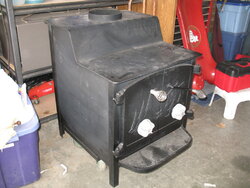
Old style box after 1980 with Cathedral doors.
This one was fitted with shields so it does have UL tag attached to rear shield;
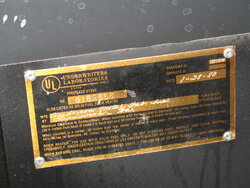


 Maybe with a top-vent system, cooking the pipe is less of a problem, I don't know. Maybe tube vs. cat is something to be considered, or bypass vs non-bypass stoves. But I know that if you floor your car a lot, it won't last as long. I don't think it takes me too much longer to ramp up to temp, running the stove moderately. Lively flame is OK but I don't want a blast furnace in there. I might have the air wide open on a re-load but once flames start getting to the top of the box, I'm cutting air.
Maybe with a top-vent system, cooking the pipe is less of a problem, I don't know. Maybe tube vs. cat is something to be considered, or bypass vs non-bypass stoves. But I know that if you floor your car a lot, it won't last as long. I don't think it takes me too much longer to ramp up to temp, running the stove moderately. Lively flame is OK but I don't want a blast furnace in there. I might have the air wide open on a re-load but once flames start getting to the top of the box, I'm cutting air.




